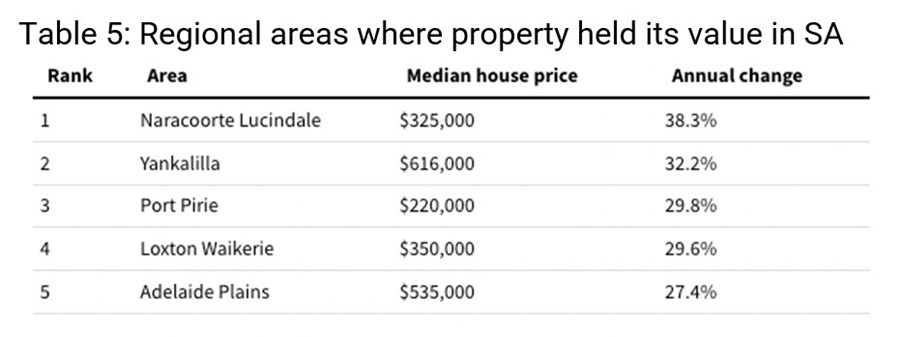From our Property Partner Domain
Aussie house prices have fallen at the fastest rate on record over the past year. For homeowners in regional areas house prices are bucking the trend (table 1). Domain’s latest data shows that house prices in many regional areas are holding their value. In fact, 92% of regional local government areas saw a property price rise in the last quarter.

Speaking about the stability of regional Australia, Domain Chief of Research and Economics, Dr Nicola Powell said, “Many regional house prices are still outperforming their city counterparts even though the pandemic-induced boom is over. The ability to work from home has allowed metro workers to continue to seek regional housing, changing the demographic and outlook of house prices in these areas.
While the price looks different to a local, someone from the city will be drawn to the area because the median price is considerably lower. That said, some regional areas that boomed earlier in the pandemic are expectedly leading the regional downturn such as popular holiday spots such as Byron Shire and Kiama.”
Although the peak rate of growth in house prices had passed, the regions appear to be less impacted as prices stabilise. House prices in Melbourne have fallen 5.6% from their peak, whereas in regional Victoria they’ve fallen 1.7% from the March 2022 peak. In Sydney, house prices have fallen 11.3% from the peak whereas in regional NSW by just 1.4%.
“The regional housing boom is starting to lose steam after interest rate rises but it’s still a great time for homeowners looking to sell. Most regional markets have hit their peak and will experience a slowdown in the annual change. But many of these regions are unlikely to head back to pre-COVID prices given that the areas are still more affordable than houses in the capitals. Regional housing markets peaked later and while we’ll likely see prices pull back, we’ll probably see a softer landing in regional areas than in the cities,” commented Powell.

Glen Innes Severn Shire, a seven-hour drive from Sydney, led the way, jumping 30.8% from a year earlier to a median of $340,000. That was followed by neighbouring Armidale Regional Council, which jumped 29.6% to $520,000, and the Upper Hunter, which jumped 22% to $455,000.
Booming house prices in Sydney have prompted people who are able to work from home, to relocate within their own states to get more bang for their buck. First-home buyers across regional NSW have also benefited from various new schemes from the NSW government. Introduced in October, the Regional First Home Buyer Guarantee will help ten thousand regional first home buyers nationally with buyers able to purchase with a low 5% deposit. New financial packages announced last week will also make it easier for teachers to take jobs at regional schools and settle in NSW communities.

The Hindmarsh, Murrindindi and Gannawarra council areas had the fastest rates of growth over the past 12 months, up 31.2%, 30% and 24% respectively. Areas such as Murrindindi which include Alexandra, Yea and Kinglake, saw increased popularity having benefited from the COVID-induced pivot to working from home. At just over an hour from Melbourne’s CBD, it offered an appealing more affordable option for commuters who only travelled to the city a couple of times a week.

The Somerset, South Burnett and Southern Downs council areas had the fastest rates of growth in Queensland with Somerset almost doubling in growth over the past 5 years. The Somerset council area is only a 60 min drive from Brisbane offering tree-changers a country escape with a relatively short commute.

Naracoorte Lucindale, Yankalilla and Port Pirie council areas saw the most growth with Naracoorte Lucindale increasing by 38.3%. This region lies on the edge of the Limestone Coast renowned for its adventure activities and nature lovers.

Toodyay, Augusta-Margaret River and Busselton took the top 3 spots for annual price growth. The Shire of Toodyay, bordering the north-eastern edge of the Perth metropolitan area is another top spot for tree-changers wanting to experience more natural beauty but within close proximity to the city at just over an hour’s commute. The Shire continues to experience a migration of people from the Perth metropolitan area who are seeking an alternative semi-rural lifestyle.
